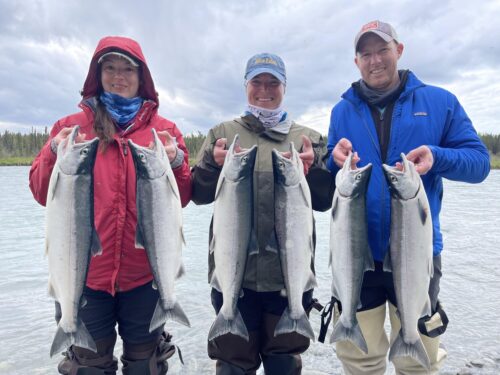
Head To The Kenai For Great Trout, Salmon Action
The following appears in the April issue of Alaska Sporting Journal:
BY CAL KELLOGG
The low gray overcast stood in stark contrast to the lush green grass along the bank and the river’s emerald-colored water.
The clouds were spitting rain; not heavy rain; rather, the stippling of fine drops veteran visitors to the Kenai Peninsula refer to as “Alaskan sunshine.” Those words allude to the fact that in summer it seems to rain a little just about every day.
Standing in a beached aluminum sled with three other anglers from the Lower
48, I was assessing the soreness in my back and shoulders I’d earned battling big Cook Inlet halibut the previous day. I listened to our guide Monte outline expectations for the day’s adventure.
“This is really pretty simple fishing,” Monte said. “When I tell you to cast, just toss your spinner toward the bank. Let it sink for a three count and start slow-rolling it back to the boat. If you feel a tug and the fish doesn’t stick, keep on reeling. Sometimes a silver will hit a spinner two or three times before
they stick. Work the lure all the way back to the side of the boat. Sometimes the salmon will follow it all the way in and strike right next to the boat.”
I’d spent a good deal of time bank fishing on the Kenai, but this was my first-ever guided trip on a boat. I didn’t know what to expect, but the instructions sounded simple enough.
Since I was hosting a group of anglers who had traveled up from California, I took a position in the back of the boat to allow my guests first crack at the silvers we hoped to battle.
After Monte positioned the boat for our first drift and instructed us to cast, Kathy, fishing up in the bow, hooked up almost the instant her spinner hit the water. In a flash Monte was at Kathy’s side, net in hand, and ready to net her acrobatic silver, which looked to be about 7 pounds.
Meanwhile, myy spinner was about three-quarters of the way back to the boat as I slowly turned the handle on the spinning reel and watched the action taking place in the front of the boat. When it came, the strike didn’t feel like a strike at all; in fact, for a few seconds
I thought I’d snagged bottom when the rod tip simply loaded up against a seemingly immovable object. Out of reflex, I wiggled the rod tip in hopes of freeing my big pink Rooster Tail. That’s when all hell broke loose.
The fish bolted toward the middle of the river and passed under the boat’s transom and engine as my spinning reel’s drag screamed. Out of instinct, I dipped the rod into the water almost to the handle and followed the fish around to the starboard side of the boat. If I hadn’t done that, I would have been cut off on the motor.
“You’ve got a king. There aren’t supposed to be many in the river right now,” Monte said with Kathy’s silver now flopping in the net.
“Keep the lines in the boat, guys. We’re going to chase this king down and flip the spinner out of its mouth,” Monte quickly instructed and stepped to the back of the boat with the bleeding silver in his hand.
Tossing the silver into the fish box, he revved the idling kicker motor into action. “Reel fast, Cal, and keep the line tight as I close on the fish. Don’t baby him. We want to bring him right up next to the boat where I can grab the spinner with my pliers.”
Less than 10 minutes later the largest king salmon I’d ever encountered was next to the boat.
As Monte went after the spinner pinned in the corner of the big salmon’s mouth, I asked, “Can I get a picture before we let it go?”
“Negative” was all Monte said as he pulled the hook loose and the massive chromer disappeared back into the Kenai’s cold, cloudy water.
When Monte stood up, he explained that Kenai king salmon were protected. There was a zero-fish limit, and it was illegal to even lift any fish over 34 inches out of the water.
“For the record, that salmon would be a real trophy pretty much anywhere except on the Kenai. I’d say that king measured 49 to 50 inches long and would weigh between 45 and 50 pounds. During the second half of summer, we see kings in the 70-pound class,” Monte told me as he motored us back toward the bank and more silvers.
I’d made one cast and landed a 45-plus-pound king salmon, which my guide didn’t consider particularly big. Such was my introduction to drift fishing on the mighty Kenai!
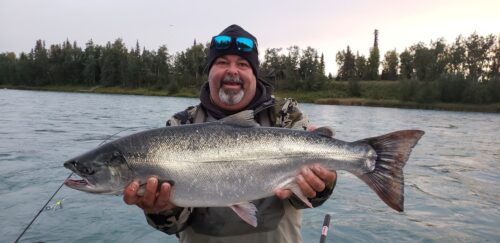
THE KENAI RIVER FISHERY
The Kenai is one of the most famous and most heavily fished rivers in Alaska. It plays host to king, silver, sockeye and pink salmon, as well as rainbow trout and Dolly Varden.
The world record 97-pound king was caught in the Kenai in 1985. While the river is known for producing huge kings overall, the run is no longer robust. In
2023, the total number of large kings in excess of 34 inches was only 14,502. As a result, king salmon retention was closed, and 2024 will be no different. For the second consecutive year, the Alaska Department of Fish and Game closed the river’s early- and late-run king seasons, with salmon anglers also restricted to fishing with unbaited single-hook artificial lures only for the duration of the spring and summer.
“The 2024 preseason forecast for Kenai River early-run king salmon is 2,630 large fish (fish greater than 34 inches in length). The total run forecast is less than the optimum escapement goal range of 3,900-6,600 fish,” an ADFG press release last month stated. “If realized, the 2024 run would rank as one of the poorest runs in 38 years.”
Now and then, a lucky angler like me will still experience the thrill of battling and releasing one while targeting other species. You’ll also sometimes see massive kings jump and crash down in an epic midriver spray of white water.
Sockeye are hands down the most popular salmon on the river among anglers. The 6- to 10-pound fish return to the Kenai in prolific numbers and are considered the finest eating salmon in the world.
Last summer’s run was especially robust, with 2.35 million sockeye running up the Kenai. With huge numbers of fish in the system, the limit was raised to six sockeye per day, 12 in possession.
Typically, the best sockeye action takes place from the middle of July through the end of August. If you’re planning a trip, the period between July 25 and August 15 generally yields good sockeye action.
Silver, or coho, salmon are another staple for Kenai anglers and are probably the most fun to catch because of their proclivity to make blistering runs culminating in wild jumps. I couldn’t get any run data on the coho return last season, but by all accounts, it was a very good year.
Mark Glassmaker of Alaska Fishing With Mark Glassmaker (mgfalaska.com) related this to me: “On the Kenai and Kasilof Rivers, the first good number of silvers arrived in mid-August, but with such a robust sockeye return and the limit being six fish for sockeye versus two fish for silvers, many opted to stick with the sockeye pursuit. By the last week of August, we were taking daily silver trips and getting consistent limits on the lower Kenai.”
The huge rainbow trout that inhabit the upper river, along with 24-plus-inch Dolly Vardens, are the Kenai’s sleeper fisheries, existing in the shadow of the river’s epic salmon runs.
I’ve wanted to experience Kenai rainbow fishing for a long time. So far, I’ve been so busy battling salmon on my Alaskan adventures that I just haven’t gotten around to chasing them, but I will.
Fueled by salmon eggs and the nutrients released into the system by spawned-out salmon, 10-pound wild rainbows are common, and I’ve heard stories about fish over 20 being landed and released. Most of the rainbows caught are landed by anglers fishing egg imitations with fly tackle or deftly drifting beads with spinning gear.
Since most anglers visiting the Kenai come in hopes of hooking sockeye and silvers, let’s take a look at how to hook these species while fishing either with a guide or on your own.
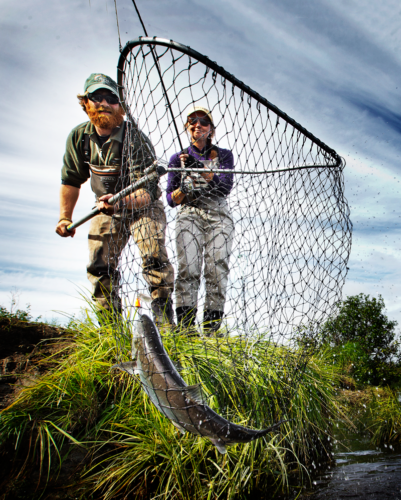
SOCKEYE TACTICS FOR KENAI SUCCESS
Sockeye salmon vary widely in terms of size from river to river. The Kenai’s sockeye are among the largest you’ll encounter. In my experience, the average sockeye runs 4 to 6 pounds, while my personal best was an 11-pound beast that fought with the power of a small tuna!
To consistently hook sockeye, the first thing to do is forget everything you think you know about fishing. Long casts and adding any action at all to your presentation will actually prevent you from hooking fish.
Short-range “lining” is the most effective and efficient way to hook up. What the heck is lining? you may be wondering.
Picture this: The Kenai is glacier fed; the emerald water has a chalky quality, which limits visibility. When sockeye are running upriver, they tend to stay tight to the banks. You’re standing on the bank or maybe in the water in knee-high waders. Ten feet in front of you in water that is 2 to 4 feet deep are dozens, perhaps hundreds of salmon constantly pushing past you.
Because of the less-than-clear water, you can’t see them, but they are there. Sometimes when wading, you’ll feel them run into your legs.
Despite the big numbers of fish, sockeye seldom hit baits or lures. They are plankton feeders, so they aren’t wired to lash out at tasty, smelly or shiny offerings like silvers and kings that spend their adult lives running down forage items such as candlefish.
Here’s how you hook sockeye: You’re armed with a spinning rod spooled up with 12- to 17-pound-test mono. Your main line is passed through a snap swivel such that it can slide up and down the line. Then a bead is added and the line is tipped with a barrel swivel. You’ll attach a Slinky-style weight to the sliding snap swivel to get your rig down.
A stout 18- to 36-inch leader is attached to the barrel swivel, with the leader tipped with a nickel- to quarter-size octopus hook. You can fish with a bare hook, but I prefer to add a little yarn. I feel the yarn leads to more hookups since it tends to tangle in the sockeye’s tiny teeth.
As for the presentation, you’ll flip 6 to 8 feet of line up and across the current at a 45-degree angle. You follow the rig’s progress as it drifts along with the rod tip. When the rig is 30 to 45 degrees downstream, smoothly lift the rig and flip it back upstream. Flip, drift, lift and repeat … You’ll lock into this fluid rhythm.
At some point when you make the lift, you’ll suddenly find your line attached to the jaw of a sockeye intent on ripping the rod out of your hand!
So how does this happen? All those salmon swimming upriver in front of you are opening and closing their mouths to let water push across their gills. Your goal is to have your leader sweep into the open mouth of one of the fish. When you make the lift, your hook is swept into the corner of the salmon’s mouth. If you are doing the “Kenai lift” correctly, 90 percent of the fish you hook will have the hook pinned through the corner of the mouth from the outside in.
Are there finer points? Of course. For example, you need to adjust your weight to the drift you are fishing. You want your gear right off the bottom, with the sinker occasionally ticking the rocks. Too much weight and your gear won’t sweep across the bottom properly. Too little weight and the rig won’t get deep enough.
Visiting anglers typically elevate the rod tip and enjoy the fight of the salmon. That’s all fun and games, but this approach encourages the salmon to jump, increasing the chances of losing a great-eating fish.
When you watch an Alaskan angler battle a sockeye, they keep the line tight with a low rod tip, encouraging the fish to stay beneath the surface. These folks typically fish in pairs. When one angler hooks up, the other moves into position downstream from them with the net. When the salmon is just upriver of the net holder, the angler fighting the salmon elevates the rod tip, the salmon boils to the top and the netter makes the scoop. It’s a sweet system that maximizes the number of salmon landed.
If you book a guided sockeye trip, the guide will motor you to one of his pet gravel bars and anchor the boat. Your group will jump out wearing waders, line up and begin performing the Kenai lift. The guide will rove among the anglers, dialing in gear and technique. When you hook up, he will net your fish.
If you choose to fish on your own, the technique is the same, but you’ll be fishing with other anglers – both locals and tourists from the Lower 48 and other countries. There are a lot of access points for freelance anglers. For example, the town of Soldotna has constructed a series of impressive aluminum staircases, which anglers use to access a prime stretch of river.
If you’re a freelancer, just stop into one of the Kenai Peninsula’s small tackle shops and they will point you to where the best fishing is taking place currently.
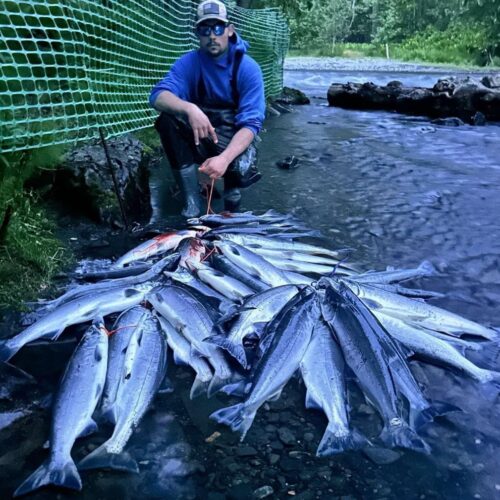
SILVERS ON SPINNERS
If you’ve ever fished for trout in a stream using spinning gear with salmon eggs and spinners, you’ll understand the fundamentals of hooking silvers on the Kenai. Some anglers swear by drifting roe. Roe can be deadly, and I’ve had a lot of fun drifting it with and without a bobber, but most of the time you don’t need to employ bait.
Silver salmon are aggressive biters and love to blitz spinners. There are a lot of different spinners used for silvers, and there are some local favorites you’ll only find in Alaskan tackle shops. I’ve always enjoyed good success with Rooster Tail and Blue Fox spinners.
My hands-down all-time favorite is a pink spinner with a silver blade, but at times color makes a difference. If you’re freelancing, you’ll want pink, orange, chartreuse and metallic colors, including metallic blue. I’ve found 1?2-ounce models to be a good all-around choice.
If you’re fishing with a guide, the spinning rod and spinner will be furnished. If the guide hands you a rod with a scratched and beat-up spinner attached to it, that’s a good thing. You’ll be fishing a lure that has caught dozens of fish. Some individual spinners put off just the right sound to drive silvers nuts!
On a guided trip, you may jump out and fish from the bank at times, but in general you’ll be making your casts from the boat. Obviously, when freelancing on your own, you’ll be bank fishing and wading.
Again, if you’re a freelancer, there are a lot of places to fish. The staff at local tackle shops will point you in the right direction.
Fishing for silvers typically requires a little more patience than fishing for sockeye. The silvers won’t be moving in big dense clouds like the sockeye. At times, you’ll have to invest several casts to catch the eye of a passing coho.
The basic bank fishing presentation looks like this. Cast the spinner up and across the current. If the run is deep, let the spinner sink a bit before you begin slow-rolling it in just fast enough to make the blade turn.
Work the lure all the way back to your feet. Silvers have a habit of following a spinner and smacking it at the last possible second. If you feel a strike but the fish doesn’t stick, don’t break rhythm with the reel. Keep the spinner moving at the same pace and the fish will often come back and hit the bait again.
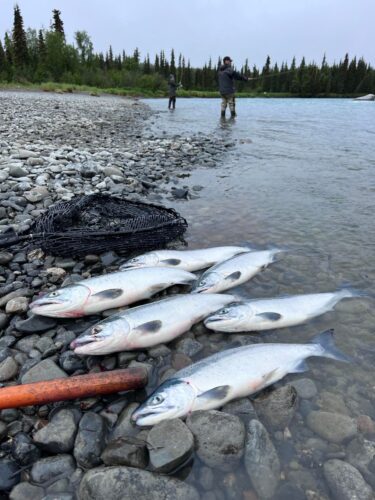
FINAL TIPS
If you are heading to the Kenai to chase sockeye and coho, you can get waders once you arrive in Alaska; many outfitters furnish them for their guests. I prefer to bring my own neoprene waders. That way I know my waders will fit perfectly and won’t have any tiny leaks.
When fishing for sockeye, you’ll always be around other anglers wielding hooks. For this reason, you’ll want to be wearing eye protection in the form of sunglasses. I typically carry a pair of dark glasses for sunny days and some with amber lenses for overcast days. I’ve never seen anyone hooked, but it does happen. A hook in the ear or lip is a bummer. A hook in the eye is serious!
Finally, if you are on your first Kenai adventure, don’t forget your raingear for that drizzly Alaskan sunshine. While pursuing the river’s summer salmon runs, you will almost certainly find yourself standing out in the rain! ASJ
Editor’s note: Cal Kellogg is a longtime Northern California outdoors writer and editor and guide. Subscribe to his YouTube channel Fish Hunt Shoot Productions at youtube.com/user/KelloggOutdoors.
